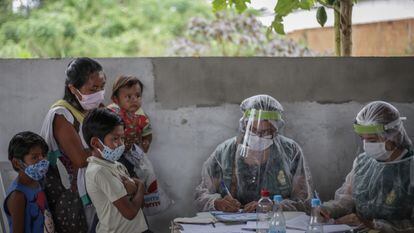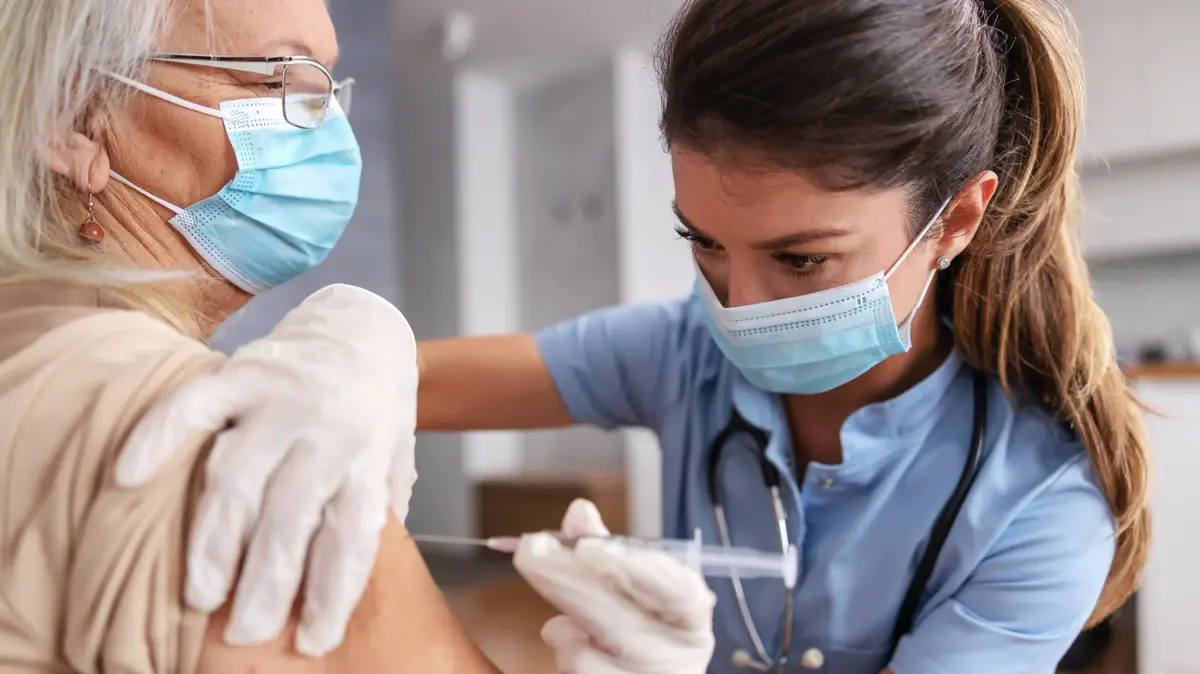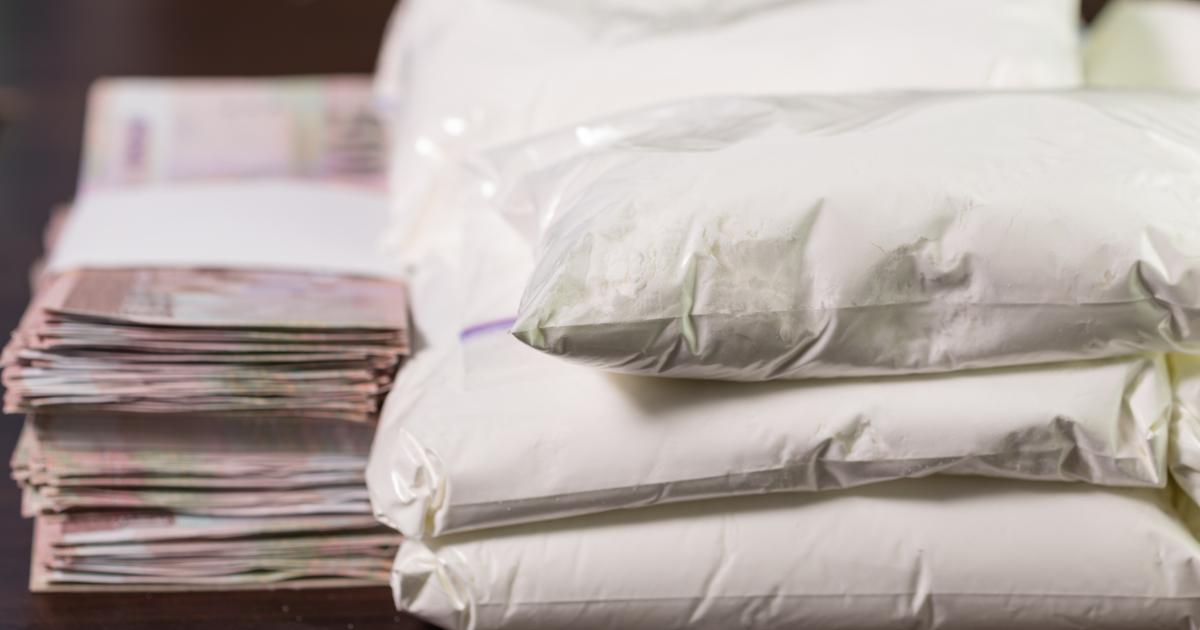A woman waits to be vaccinated against COVID-19 in Rio de Janeiro, on July 31, 2021.NurPhoto via Getty Images
The first news appeared in December: South America, with its diplomatic and budgetary juggling to access vaccines, its treacherous rates of mortality from covid, its eternal quarantines and its polarization, had positioned itself in first place in the world in percentage of total population vaccinated, a position that continues to this day. According to Our World in Data statistics updated to January 5, South America has 76% of people vaccinated with at least one dose and 64% with the complete schedule, above Europe (66% and 62%) and the United States. United States (74% and 62%), for using as examples a region and a country that far exceed the Southern Cone in availability and access to vaccines.
What happened so that the region that has the country with the highest number of deaths per inhabitant due to the pandemic - Peru - and the second with the highest number of deaths in total - Brazil - (whose president has even said that if the vaccine "It turns you into an alligator, it's your problem"), would it become the global leader in vaccination? The question itself contains part of the answer. The fear of the havoc that the coronavirus has caused in the region, much more concrete and powerful than any anti-vaccine conspiracy discourse, is not enough to explain the progress in the immunization of societies that have had to overcome economic, geographical and structural obstacles to reach the arms of its citizens.
Although the answer is multiple and varies from country to country, it is also possible to trace common factors in the region, especially historical ones, such as the existence of a deep-rooted culture of vaccination or the roots of health systems that, no matter how fragile and weakened they may have been. reached the pandemic, they still retain a vocation for public service and infrastructures that could be partially reactivated at the service of vaccination. And also the need to subsist in economies with very high rates of informality. A factor that, in reality, could be considered conjunctural and historical at the same time: the habit and the need to subsist. These are the keys that have led some of the main countries in the region to achieve such good percentages:
Brazil: an extraordinary achievement despite presidential denial
The percentage of Brazilians vaccinated against covid exceeds the world and regional averages: an extraordinary achievement for the most populous country in South America, which is also led by one of the few heads of state in the world who has openly rejected immunization and has even widespread misinformation about vaccines. 67% of the 210 million Brazilians have the complete regimen and another 11%, the first dose, according to Our World in Data.
The secret to this success is made up of several factors.
First, the capillarity of the Brazilian public health system (SUS), which reaches the last corner of this country.
Second, with initial problems in purchasing vaccines resolved, when supply normalized in July, the system displayed its strength.
Some days two million doses were put in.
Third, they are all facilities: many points to receive the puncture and long hours.
Additionally, omicron fears have shortened the timeline for the booster dose.
Health personnel take the data from a woman with her children for vaccination against covid-19 in Manaus, Brazil.Andre Coelho (EL PAÍS)
Brazil, where the covid has killed more than 600,000 people, started with an advantage.
Confidence in vaccines and the SUS is so great that the presidential discourse of sowing doubts about immunization has had little impact even among Bolsonarians.
They are decades of solid campaigns that even have a mascot: Zé Gotinha (José Gotita).
And two more factors: the economic elite got the federal government to embrace (albeit reluctantly here and there) immunization when it publicly warned that it was essential to revive the economy.
And teenagers have been enthusiastically vaccinated, whatever it takes to once again enjoy the most anticipated party of the year, Carnival.
Argentina: tradition and Sputnik
Argentina has applied almost 78 million vaccines against the coronavirus, the second highest number in South America after Brazil. 84% of the population have at least one dose, 72.9% have two and 14% have already received a third booster. Anti-vaccine movements are a minority in the country and are not organized. Although it has cost the Government to reach the 16% that have not yet been vaccinated, the high percentages of application have to do with an ingrained health culture. Babies receive their first vaccination minutes after they are born; When they grow up, they cannot enter the educational system if they do not present the card that shows that they have the mandatory doses applied. "We have one of the most complete vaccination schedules in Latin America," explains a source from the Argentine government.“Vaccination is something that the population of our country has culturally incorporated. In addition to that, the history of the N1H1 flu also served as an experience to introduce something out of the ordinary into the normal vaccination schedule, ”such as the doses against covid-19.
Guaranteeing dosages was, however, an uphill road. Months after the start of the pandemic, Argentina celebrated as a great triumph the agreement with Astrazeneca to produce millions of doses together with Mexico. But things did not go as expected and, when it was already evident that the contract could not be fulfilled (Mexico argued that it was not getting the necessary supplies in the market to fulfill its part), the Casa Rosada opted for the Russian Sputnik V vaccine. Argentina was one of the first countries to approve the use of the Russian vial, which allowed it to start the application of the vaccine at the end of December 2020. The commitment to Moscow earned the Government of Alberto Fernández harsh criticism from the conservative opposition, who He accused him of displacing American laboratories like Pfizer on ideological grounds.A year after those debates, the supply is normalized and there is no shortage of vaccines in the country. The Ministry of Health today has in
Stock
17 million doses from six different laboratories.
Chile: history, economic openness and public / private collaboration
Chile, as it has done from the beginning, takes the regional leadership in vaccination against covid-19. President Sebastián Piñera, who leaves office in March, has announced that a new reinforcement process will start on Monday with the application of the fourth dose, initially focused on the immunosuppressed. It does so precisely when infections increase in midsummer - 3,134 were reported this Thursday, as had not been seen six months ago - and the Ministry of Health seeks to maintain the population's immunity against the virus and its omicron variant, which is not yet predominant . Because Chile, with a successful vaccination process, has managed to ensure that 92.2% of the population that can be punctured complete their immunization schedule against covid-19.
The reasons for its success are multiple and combine historical and circumstantial elements. At the base is a robust primary health system that was set up in the 1950s and that, despite the dictatorship of Augusto Pinochet, continues to maintain its muscles throughout the territory. Although it is a country with complex geography, clinics are even in remote places, which adds to the fact that throughout the country there is a strong culture of vaccination from an early age. The high immunization rates are explained, in parallel, because Chile has one of the most open economies in the world since the 1990s, which is why there is a strong commercial tradition abroad, which facilitated negotiations to obtain the different formulas early. . Up to now,Almost 50 million doses have reached the country, mostly from Sinovac and Pfizer-BioNTech laboratories. But the Government also maintains agreements and contracts with AstraZeneca, CanSino (Saval), Janssen (Johnson & Johnson), and the Russian Sputnik V vaccine, approved in Chile for those over 18 years of age.
The collaboration of the public and private health systems has been crucial: in the context of the pandemic, they have acted as the same block.
The collaboration of the universities and the negotiating nose of President Piñera himself, with recognized talent for companies, are other elements that explain Chile's success in obtaining vaccines and its successful immunization process.
Colombia: Covax, delay and take off
Although Colombia did not achieve its goal of immunizing 70% of the population of 50 million inhabitants with two doses by the end of 2021, it closed the year with 75.4% of the population with the first dose, 55.7% vaccinated with the full scheme and 6.5% with a booster dose, according to Our World in Data. As a starting point, the country had a solid vaccination record, without major adverse movements, and one of the largest programs in the region, with free rights to 21 vaccines that protect against 26 diseases.
In March, Colombia also became the first country in Latin America - and one of the first in the world - to receive vaccines through the Covax mechanism led by the World Health Organization (WHO). This Monday it was known that the Spanish Government will donate in the coming weeks a new batch of almost 5.5 million through Covax, for a total of 6.5 million, which places Spain as the first international donor of vaccines to Colombia (followed by the United States, with another 6 million). It is a reflection of the bet on several bands that Bogotá designed. The Government chose to combine this multilateral strategy with several bilateral negotiations with pharmaceutical companies. To these two mechanisms is added the participation of the private company, which acquired and administered on its own two million doses for employees and their families.
“Having acquired a diversified portfolio was key, the population is administered five vaccines [Pfizer, Sinovac, AstraZeneca, Janssen and Moderna], so that, when one of them has been scarce, another has come to supply the demand, avoiding falls drastic ”, says Carlos Dáguer, author of several books on public health and representative of health insurers.
When the pace began to slow, the government decided to require that citizens be vaccinated to enter restaurants and entertainment venues, and extend the vaccination to groups of three years and older.
"Asking for the vaccination card in leisure places has allowed us to grow very significantly in young people," said the Minister of Health, Fernando Ruiz in December.
Peru: fatality, economy and vaccinations
The Andean country received the first batch of Chinese vaccines (from Sinopharm) on February 7, 2021 - late, compared to some neighboring countries - and administered them to health personnel and security forces. In the following months, the number of vaccinators and vaccinated was moderate in proportion to the availability of vaccines. The Government of Francisco Sagasti ended in July with 18% of adults vaccinated, while the Castillo administration closed 2021 with 80% of the population over 12 years immunized.
Several factors explain why most turned to vaccinations in the second half of 2021, despite strong anti-vaccine campaigns. Peru was the country with the highest fatality rate in the world due to covid-19 - with almost 6,000 deaths per million inhabitants - and it also had the highest number of children - globally - who were orphaned by the new coronavirus. Death was so close and common that the population preferred to rely on the vaccine to the possibility of having to face a serious illness that required oxygen and beds in Intensive Care Units. They had plenty of reasons: in the first half of 2021, Peruvians had suffered thousands of deaths due to lack of ICU beds or money to buy expensive oxygen from private individuals, since the health system was in short supply.
In this context, the promise of the vaccine made sense, and the Ministry of Health administered it in vaccinations, vaccinations, and house-to-house in remote communities in the Andes and the Amazon. The health authority worked in the regions to alleviate anti-vaccine misinformation. On the other hand, the Peruvian economy fell 11% in the first year of the pandemic and informal employment went from 72% to 78%: immunization could provide some protection when resuming economic activities. In addition, in November 2021, the Government ordered mandatory vaccination in companies with more than 10 workers - which would take effect in mid-December - which pushed thousands of laggards to get immunized. The same happened when, in anticipation of the arrival of the omicron variant and the proximity of the end of the year parties,The health authority ordered the obligation - as of December 10 - to show the vaccination card with two doses to enter shopping centers, restaurants, cinemas.
Subscribe here to the EL PAÍS América newsletter and receive all the informational keys of the current situation in the region









